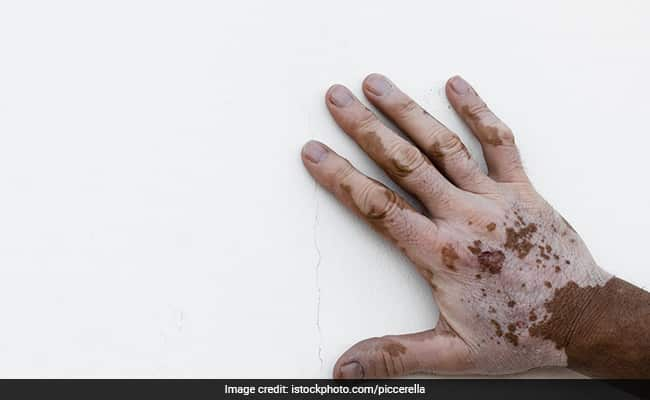Vitiligo
What is it?
Vitiligo, also known as leucoderma, is a relatively common skin disorder, in which white spots or patches appear on the skin. These spots are caused by destruction or weakening of the pigment cells in those areas, resulting in the pigment being destroyed or no longer produced. In most cases, vitiligo is believed to be an autoimmune-related disorder. In vitiligo, only the colour of the skin is affected but texture and other skin qualities remain normal.
What are the causes?
Vitiligo occurs when melanin — the dark pigment in the epidermis that gives the skin its normal colour — is destroyed or not produced. The involved patch of skin then becomes white. Why this occurs isn't known.
What are the symptoms?
People who develop vitiligo usually first notice white patches or spots (depigmentation) on their skin. The skin remains of normal texture, and there is usually no itching or other symptoms. These patches are more obvious in sun-exposed areas, including the hands, feet, arms, legs face, and lips. Other common areas for white patches to appear are the armpits and groin and around the mouth, eyes, nostrils, navel, and genitals. Vitiligo generally appears in one of three patterns. In one pattern (focal pattern), the depigmentation is limited to one or only a few areas. Some people develop depigmented patches on only one side of their bodies (segmental vitiligo). But for most people who have vitiligo, depigmentation occurs on different parts of the body (generalised vitiligo), often similar on each side of the body. In addition to white patches on the skin, some people with vitiligo may experience white hair growing in on the scalp, eyelashes, eyebrows, and beard. In extremely rare cases, vitiligo can affect eye color or the pigment of the retina.
How is the diagnosis made?
If a doctor suspects that a person has vitiligo, he or she usually begins by asking the person about his or her medical history. Important factors in a person's medical history are a family history of vitiligo; a rash, sunburn, or other skin trauma at the site of vitiligo 2 to 3 months before depigmentation started; stress or physical illness; and premature graying of the hair (before age 35). In addition, the doctor will need to know whether the patient or anyone in the patient's family has had any autoimmune disorders and whether the patient is very sensitive to the sun. The doctor will then examine the patient to rule out other medical problems. The doctor may take a small sample (biopsy) of the affected skin. He or she may also take a blood sample to check the blood-cell count and thyroid function. Most certainly, the doctor will examine the skin with a special black light called a Woods Light, which illuminates areas of vitiligo. This also helps the doctor rule out other conditions. For some patients, the doctor may recommend an eye examination to check for uveitis (inflammation of part of the eye). A blood test to look for the presence of antinuclear antibodies (a type of autoantibody) may also be done. This test helps determine if the patient has any other autoimmune conditions.
What is the treatment?
Today, there is more research and more treatments options available than ever before. In addition to the traditional therapies such as the PUVA system and steroid creams, new technologies have been developed, including narrow-band UVB, Pseudocatalase cream, excimer lasers, skin grafting and pigment transplantation, topical psoralens, and potentially, the use of immunomodulators. Depending on the number, size and location of the white patches, one may decide to seek medical treatment. Medical treatments for vitiligo aim to even out skin tone, either by restoring colour (pigment) or destroying the remaining colour. Depending on the type of therapy, treatment for vitiligo may take from six to 18 months. Medical treatment choices are based on the number of white patches and how widespread they are. Each person responds differently to treatment. There is no one treatment that works for everyone. Different therapies work better for different people. While one person may respond extremely well to PUVA, another may respond better to narrow band UVB or immunomodulators. For this reason, many vitiligo experts will try different therapies on a patient until they find what works best for that person.Lifestyle and home remediesCertain self-care tactics may help care for the skin and improve its appearance: Protect the skin - If one has vitiligo, then he/she should use sunscreen to protect the skin from the sun's harmful rays. Sunscreen helps protect the skin from sunburn and long-term damage. Sunscreen also minimises tanning, which makes the contrast between normal and depigmented skin less noticeable. Conceal imperfections. Cosmetics may lessen the appearance of the white patches and help feel better about oneself. These cosmetic products may be particularly effective if vitiligo is limited to only certain areas of the body.
What are the prevention?
No, there is no definite method by which Vitiligo can be prevented. However, some measures may be taken to minimise its effects. People with or without the condition should always use sunscreen lotions or sunblocks with a sun protection factor (SPF) of 15 or more to protect the skin against the harmful effects of UV rays. This should especially be the case after participating in outdoor sports like swimming.Most patients with vitiligo undergo emotional trauma related to their looks and social image, especially the young. They should be reassured and supported. The treatment in most cases is effective and should be continued till the desired results are obtained.
................... Advertisement ...................
................... Advertisement ...................
................... Advertisement ...................
................... Advertisement ...................



















